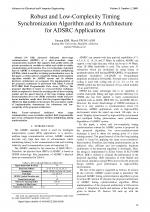| 3/2009 - 8 |
Robust and Low-Complexity Timing Synchronization Algorithm and its Architecture for ADSRC ApplicationsKIM, J. |
| Extra paper information in |
| Click to see author's profile in |
| Download PDF |
Author keywords
advanced dedicated short range communication, cross-correlation method, field programmable gate array, orthogonal frequency division multiplexing, timing synchronization
References keywords
ofdm(9), synchronization(6), timing(5), communications(5), electronics(4)
Blue keywords are present in both the references section and the paper title.
About this article
Date of Publication: 2009-10-26
Volume 9, Issue 3, Year 2009, On page(s): 39 - 44
ISSN: 1582-7445, e-ISSN: 1844-7600
Digital Object Identifier: 10.4316/AECE.2009.03008
Web of Science Accession Number: 000271872000008
SCOPUS ID: 77954752385
Abstract
5.9 GHz advanced dedicated short range communications (ADSRC) is a short-to-medium range communication standard that supports both public safety and private operations in roadside-to-vehicle and vehicle-to-vehicle communication environments. The core technology of physical layer in ADSRC is orthogonal frequency division multiplexing (OFDM), which is sensitive to timing synchronization error. In this paper, a robust and low-complexity timing synchronization algorithm suitable for ADSRC system and its efficient hardware architecture are proposed. The implementation of the proposed architecture is performed with Xilinx Vertex-II XC2V1000 Field Programmable Gate Array (FPGA). The proposed algorithm is based on cross-correlation technique, which is employed to detect the starting point of short training symbol and the guard interval of the long training symbol. Synchronization error rate (SER) evaluation results and post-layout simulation results show that the proposed algorithm is efficient in high-mobility environments. The post-layout results of implementation demonstrate the robustness and low-complexity of the proposed architecture. |
| References | | | Cited By |
Web of Science® Times Cited: 1 [View]
View record in Web of Science® [View]
View Related Records® [View]
Updated 2 weeks, 4 days ago
SCOPUS® Times Cited: 1
View record in SCOPUS® [Free preview]
View citations in SCOPUS® [Free preview]
[1] A New Parametric DFT-Based OFDM Transceiver for Intrinsic Wireless Communication Encryption, CHERGUI, L., BOUGUEZEL, S., Advances in Electrical and Computer Engineering, ISSN 1582-7445, Issue 1, Volume 24, 2024.
Digital Object Identifier: 10.4316/AECE.2024.01002 [CrossRef] [Full text]
Disclaimer: All information displayed above was retrieved by using remote connections to respective databases. For the best user experience, we update all data by using background processes, and use caches in order to reduce the load on the servers we retrieve the information from. As we have no control on the availability of the database servers and sometimes the Internet connectivity may be affected, we do not guarantee the information is correct or complete. For the most accurate data, please always consult the database sites directly. Some external links require authentication or an institutional subscription.
Web of Science® is a registered trademark of Clarivate Analytics, Scopus® is a registered trademark of Elsevier B.V., other product names, company names, brand names, trademarks and logos are the property of their respective owners.
Faculty of Electrical Engineering and Computer Science
Stefan cel Mare University of Suceava, Romania
All rights reserved: Advances in Electrical and Computer Engineering is a registered trademark of the Stefan cel Mare University of Suceava. No part of this publication may be reproduced, stored in a retrieval system, photocopied, recorded or archived, without the written permission from the Editor. When authors submit their papers for publication, they agree that the copyright for their article be transferred to the Faculty of Electrical Engineering and Computer Science, Stefan cel Mare University of Suceava, Romania, if and only if the articles are accepted for publication. The copyright covers the exclusive rights to reproduce and distribute the article, including reprints and translations.
Permission for other use: The copyright owner's consent does not extend to copying for general distribution, for promotion, for creating new works, or for resale. Specific written permission must be obtained from the Editor for such copying. Direct linking to files hosted on this website is strictly prohibited.
Disclaimer: Whilst every effort is made by the publishers and editorial board to see that no inaccurate or misleading data, opinions or statements appear in this journal, they wish to make it clear that all information and opinions formulated in the articles, as well as linguistic accuracy, are the sole responsibility of the author.



